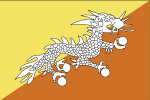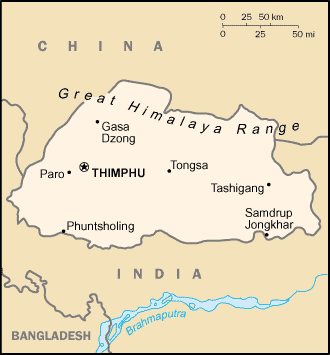
People
The
official estimate of Bhutan's population in 1990 was about 600,000
but other sources estimate the population for 2000 was just under 2
million. Those living in Bhutan of Nepali origin have been
excluded from the official census since 1990 which results in such a
large discrepancy in population numbers.
Bhutan
has four major ethic groups: Bhutia, Sharchops, Nepali, and other
indigenous groups. The Bhutia, who are descended from
Tibetans, live in the central and northern regions of Bhutan.
This ethnic group basically dominates politics in Bhutan
particularly with it's contribution of government officials and
monks that come from it.
Believed
to be Bhutan's earliest settlers, the Sharchops live in the
southeastern and eastern region. They speak both Tibeto-Burman
languages as well as Hindi.
The
Nepali people are the latest immigrants to Bhutan. Living in
the southwestern and south central section of Bhutan, immigration of
Nepali's has been forbidden by the Bhutanese government since 1959.
Fear of Bhutan becoming too heavily populated with Nepalis brought
about this and the ban on living in the central Himalayan region.
Bhutan traditions and culture are to be retained and not dilute
Bhutanese distinctiveness.
There
are small groups of ethnic minorities that live all throughout
Bhutan with the largest group living in the Duars. This group
is related to those groups living in India's Assam and Bangla
states.
Education
School
is not compulsory, but is free in Bhutan. Up until the 1960s
there hadn't been a formal schooling system, apart from religious
ones. Unfortunately, the children in Bhutan do not have easy
access to schools, so attendance is fairly low - with approximately
25% of the children attending primary school and only 5% attending
secondary school in 1998. Within these numbers, the ratio of
boys attending school is much higher than that of girls.
Bhutan
has some institutions of higher learning: a four-year college, a
junior college and two technical schools. A lot of Bhutanese
students obtain grants to go overseas to the United States, the
United Kingdom, Australia, Singapore, Japan and India to complete
their studies. Upon return to Bhutan, students are briefed on
the country's currents needs. After this, the students are
then required to work in rural areas spending about six months or so
helping the villagers improve their way of life by building schools,
running medical clinics and building irrigation systems.
Economy
In spite
of the fact tourism brings in the largest supply of foreign
exchange, the Bhutan government has restricted visitors in an effort
to preserve the traditions and culture of the country. The
country was rated one of the least developed nations in the world by
the United Nations. Most Bhutanese are employed in agriculture
or related fields. Most of the agriculture in Bhutan is
cultivated simply to meet the needs of the country.
Unfortunately, as Bhutan's culture and traditions are kept in tact,
so are their farming practices which consists of hard, physical
labor.
Travel
Guide
Transportation
Air
transportation is available in Bhutan with an international airport
linking Bhutan to Bangladesh, Nepal, and Thailand. Bhutan's
national carrier, Druk Air, was founded in 1983. A road system
is available but is not extensive by any means. The roads, cut
into the mountains and hills, are frequently blocked due to
landslides in the rainy season. A bus service is available to
travel all over Bhutan, operated by the Bhutan Government Transport
Service.
Language
Dzongkha,
Bhutan's official national language, which is based on Tibetan, also
uses the Tibetan script (chhokey) for writing. Another
language derived from Tibetan is Ngalopkha, a language spoken in
western Bhutan. The south uses Nepali as it's language, while the
main language in eastern Bhutan is Sharchopkha (Indo-Mongoloid
language).

Geography
Bhutan's
climate is as diverse as it's land. Depending on the altitude,
area and amount of sunlight, the climate can range from bitter cold
to a humid, hot tropical climate. The precipitation that
Bhutan gets comes between the months of June to September and
averages for the year about 25 inches (650 mm).
A small
country covering a little over 18,000 sq mi (47,000 sq km), Bhutan's
land is very varied. Snow peaks in the Himalayas, swamps and
highlands are just some of the land conditions that are found in a
short range from each other. The three main areas in Bhutan
are the Great Himalayan Region, Middle Himalayan Region and the
Duars.
The Duars, a plain only 5-8 miles wide (8-13 km), are located along the
Indian border and have a tropical climate. The northern
section of the Duars is home to wildlife such as tigers and deer
with its rugged, coarse terrain. The southern portion of the
Duars is cultivated for rice, but had at one time been a jungle
filled with bamboo.
The
Middle Himalayan region is part of the Himalayan range that spreads
down from the north and surrounds rich, broad valleys. The
valleys, with their mild climate are cultivated and populated.
The rainfall in this region is average, not humid and wet like the
Duars.
The
Great Himalayan Region borders Tibet and is relatively
uninhabitable. The highest peak in Bhutan is located here,
Kula Kangri (4,900-9,200 ft/1,500-2,800 m). The high valleys
are home to a few people, but the main inhabitants in the bitterly
cold climate are Bhutanese yaks.
History
Not much
is identified with Bhutan's history before the 7th century, which is
when Buddhism was introduced. After this time, the chronicles
kept by Buddhists record Bhutan's history. Buddhism was
brought in to Bhutan when the country was ruled by feudal lords in
their separate valleys, not a central government.
After
monks from the Kargyupa sect of Mahayana Buddhism built monasteries
throughout the valleys, the Drukpa subsect became the most popular
form of religion. A Drukpa monk, Ngawang Namgyal, started the
first formal government in 1616 - that of a theocratic
government. Namgyal was able to unite the influential
Bhutanese families, this after he defeated many challengers subsect
leaders.
Namgyal's
government consisted of two leaders - one with spiritual
responsibilities (dharma raja) and the other with civil
responsibilities (deb raja). This split form of
government continued until the early 1900's.
Conflict
occurred in Bhutan approximately 100 years after the deb raja
formed a peace treaty with the English East India Company.
Rivalry was rampant between two governors in Bhutan (of Tongsa and
Paro) who held staunchly opposite views toward the British.
Ugyen Wangchuck, the pro-British governor, was able to unite the
country after defeating all his opponents.
In 1907
Ugyen Wangchuck became the first druk gyalpo of Bhutan and he ruled
from 1907 to 1926. Jigme Wangchuck, Ugyen's son, ruled from
1926 to 1952 and was followed by Jigme Dorji Wangchuck who ruled
from 1953 to 1972. The fourth druk gyalpo, Jigme Singye
Wangchuck began his reign in 1972.
Religion
The
majority, roughly 75 percent, of Bhutan's population practices
Mahayana Buddhism which is similar to Tibetan/Lamaist Buddhism.
After Buddhism, Hinduism is the next most popular religion.
There is a broad range of Hinduism that is practiced ranging from
traditional Hinduism to a combination of Buddhism/Hinduism where
gods in both religions are worshipped.
Wildlife
Deer and
tigers are some of the wild animals found in the rugged terrain of
the northern Duars. Northern Bhutan is home to Bhutanese yaks that
live in the high valleys of the region.
Customs
Men and
women in Bhutan wear traditional clothing. Clothing for men
consists of a gho, which is a garment that wraps around the
body like a coat that reaches the knee and is worn with a belt.
The kira is the what women wear. It is a dress that is
made from a piece of cloth (in the shape of a rectangle) that
reaches the ankles. It is secured at the shoulders with a
clip, while a woven belt holds the dress closed and in place.
Both sexes used scarves or shawls and on occasion, men will wear
earrings as well.
Travel
Guide
|



